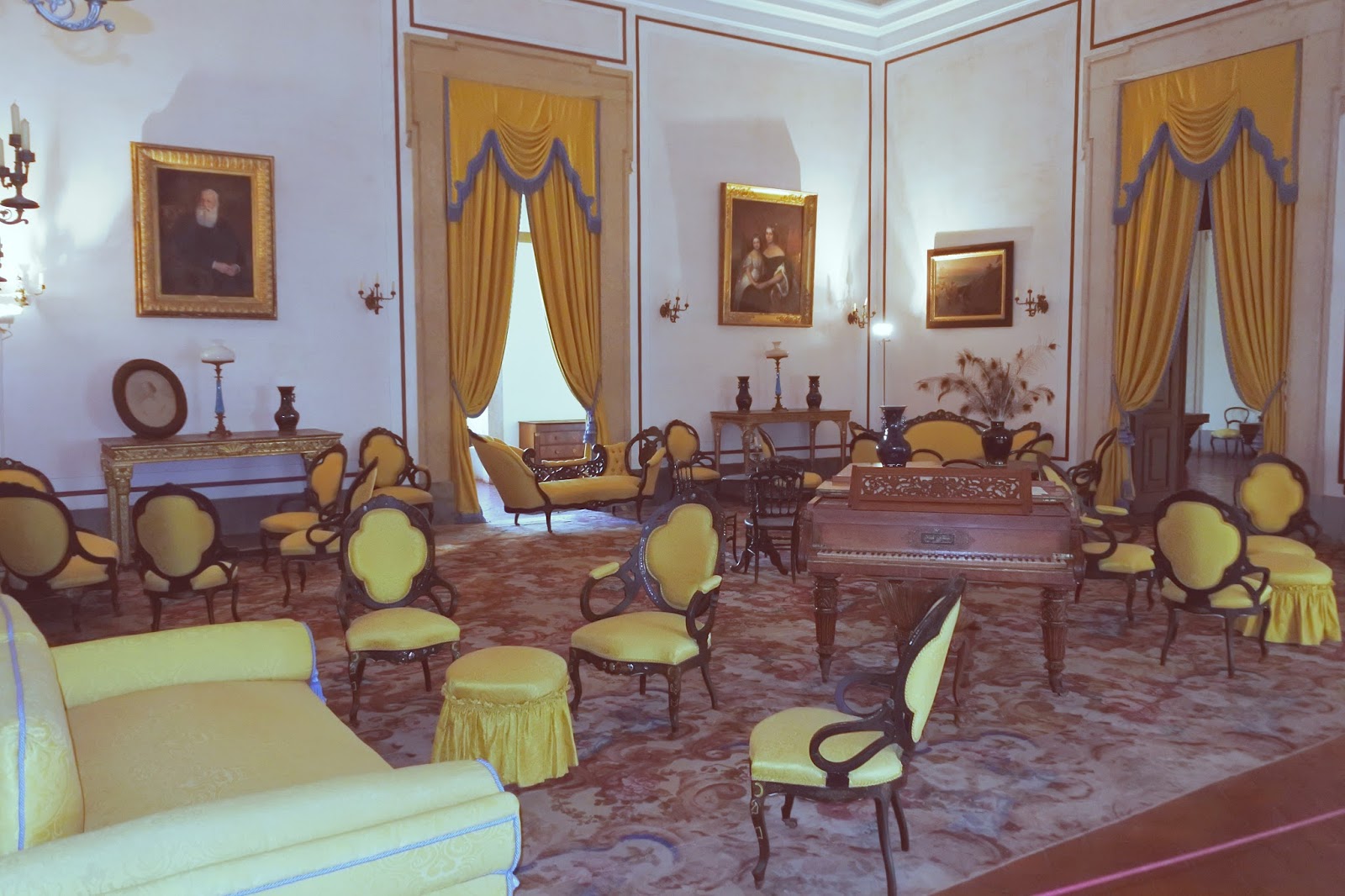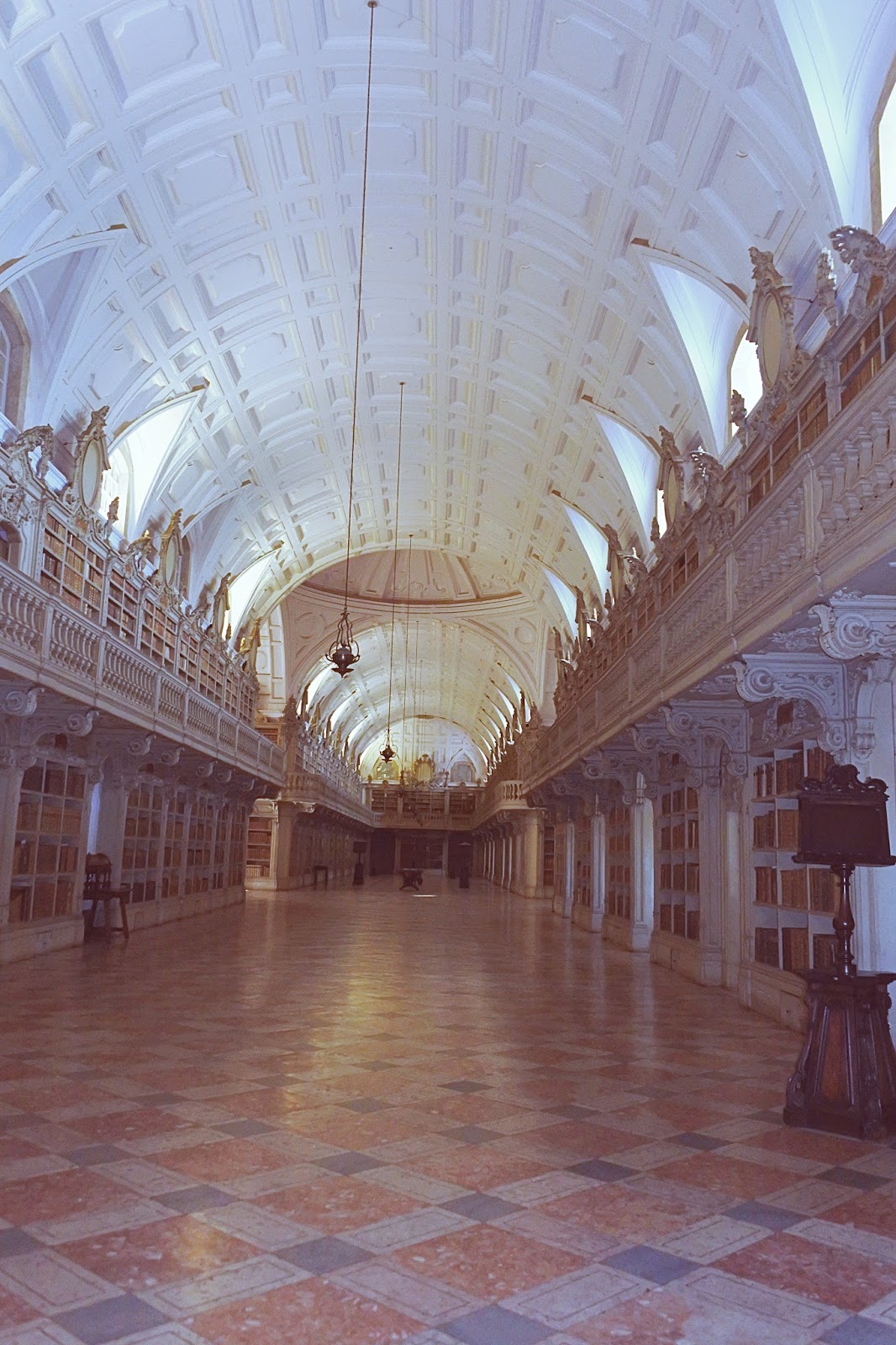
Mafra
This town near Lisbon, in the "saloia" (rustic) area, which used to supply the capital with garden produce, is famous for its imposing Palace-Convent, the largest edifice in Portugal, built by order of King Dom João V in the 18th century. The king, who still had no children three years after his marriage to Dona Maria Ana of Austria, promised the Franciscan firars that he would build them a convent in the Mafra area if his prayers for an heir to the throne were answered.
So, on the occasion of the birth of his daughter Dona Maria Pia, he began the building, the plan for which was initially quite modest. After the German architect Ludwig was contracted, however, the plan underwent considerable changes as a result of the luxury Portugal was experiencing at the time on account of the wealth coming from Brazil. Hence this grandiose monument was built, (including a convent for 300 friars, a basilica and a 666-room royal palace), in a record time, from 1717 to 1730, to be inaugurated on the king´s 41st birthday.
The Mafra Preserve which adjoins the Convent, acquired by King Dom João IV in the mid-18th century to enhance the value of the set of buildings, was used as a game reserve, and is now open to the public.
In the surrounding area, it is worth visiting José Franco's ceramics workshop in village of Sobreiro, where you can appreciate the more traditional aspects of life in the local villages, life-sized or in animated miniature and the Mata Pequena village.


I had a wow moment when I paid a visit to Mafra to put my eyes on this amazing glorious Palace. In every room I was whispering “oh! Look at that!” - definitely it was a delightful tour. Enjoy it!!!!
Palácio Nacional de Mafra (National Palace)
The Baroque and Italianized Neoclassical palace-monastery was built in the 18th Century on the orders of King John V (1689-1750) and is probably the most important monument found in the country in the Portuguese Baroque style. Organised symmetrically, the building evolves from its central axis with its white, twin-towered Basilica, consecrated in October 1730, the central point of the 232-metre long façade. The Basilica is flanked by the yellow façade of the Palace with the King’s apartments at one end and the Queen’s at the other – although the building never did serve as a royal residence, but it was used has a escape for the King, like a VK spot.
This vast complex is among the most sumptuous Baroque buildings in Portugal & one of the biggest buildings constructed in Europe during the 18th century; such displays of magnificence were only made possible by the wealth that flowed into Portugal from its overseas colony of Brazil.


 |
||
Beautiful Paintings (religious art) on the ceilings and walls - the frame work is flawless!!!


|

 |
| Monk bedrooms |


 |
| The Kitchen |


 |
| Infirmary |
The sick and injured were treated in cubicles positioned along the walls of the long hall, each screened with heavy drapes for privacy. At the head of each oak bed is a tiled panel of Christ, and at the foot, one of the Virgin Mary. At one end of the ward is a chapel, its altarpiece a depiction of "The Virgin Mary," an 18th-century oil canvas attributed to Sebastiano Conca. On Sundays, the beds were pulled in.

 |
| Bathrooms |


 |
| King's Bedroom |


Walking through the beautiful stone handmade corridors I saw huge windows and when I look through them I had the privilege to see the basilica and watch one of the rarest organ concerts (the only place in the world that you can hear six pipe organs playing at the same time) - the melody was priceless!


 |
Red Living Room(top) and the Music Yellow Room
 Game Room
Game Room |

Nursery

Exquisite furniture along the corridors


Trophy Room
The Royal Family frequently hosted shooting parties in the nearby Tapada Nacional de Mafra, the palace's extensive hunting grounds. The Trophy Room, or Sala da Caça was created to showcase the spoils of such occasions and displays a grotesque collection of nearly one hundred sets of mounted deer antlers and several boars' heads. But what truly shocks is the furniture, including the chandeliers, made from antlers and upholstered in deerskin. Fascinating, yet terribly unnecessary.



Meeting Rom




The Library
This is the largest and noblest of the palace's rooms. Designed in the form of a cross, its marble floor is 90 meters long and 9.5 meters wide. The Rococo-style wooden bookcases hold a priceless collection of more than 40,000 books in gold-embossed leather bindings. Among the more noted volumes housed here is the Nuremberg Chronicle, dated 1493, and a 1595 copy of Theatrum Orbis Terrarvm by Abraham Ortelius, considered to be the first true modern atlas. A trilingual copy of the Bible from 1514 is also stored here, while a prized first edition of Os Lusíadas (1572) by the Portuguese poet Luís de Camões is regarded as a national treasure. Not surprisingly, the public are not allowed to browse any of the books and can only proceed a short way in from the library's entrance. But it's enough to marvel at the sumptuous interior and to muse upon the fact that the valuable contents are kept free from insect infestation by a colony of bats that lives in the eaves.
To keep books from being damaged by insects, the Mafra library uses bats. 500 of them. The bats are kept in boxes during the day but at night they are let out and eat up to double their own body weight in insects. (There is a joke here about bats eating bookworms. But let’s not).
Legends tell of giant rats inhabiting the library, going out at night to hunt cats and dogs and people, and also of an underground tunnel linking the library to a small fishing resort nearby. That's why the Library was to me the highlight of the tour.


 |
| The Garden |


Down Town Mafra Coffee Shop
The main attraction of Mafra is the outstanding palace but there are few other sights to extend a visit to Mafra - for example Mafra’s town centre is pretty, with a relaxed ambience and a good selection of restaurants and cafes, ideal for a long lunch. I loved it!!!
Aldeia Típica de José Franco (Typical Village of Clay in Mafra)
As a child of the 1920´s, José Franco spent a lot of time with his parents who were professional potters. He helped them produce small ceramics that the farmers in the region used in their homes. As he got older, he began to make these pottery items, selling them door-to-door and at local festivals and fairs.
By 1945, Franco dreamed of creating an entire landscape made of miniature houses and farms. So, in the space next to his home, he built his own perfect life size typical Portuguese village of clay, reminding us of the way life used to be in Mafra when it was a more rural municipality with people engaging in various trades and crafts that have gradually began to disappear with time. Today, guests are invited to visit his “village” to learn about the customs and activities of rural life in Portugal, as well as visit the ceramic workshop in which Franco produced his creations. As a lonely man, how can you make such a Tourist Attraction? Impressive! Nice place to visit, where you can visit a typical Portuguese mini village. Easy parking. Free entry. Location well maintained. Worth the visit - I had a lot of fun in there, it brought out the kid in me.
 |
| The actual life size Village |
 |
| The mini Clay Village |





 |
| Inside the little houses |

 |
| School |





Aldeia da Mata Pequena
(Mata Pequena Village)
Restored 400-year-old village reminiscent of a fairy tale Small rural village, consisting of 13 small houses faithfully redesigned and recovered to serve as a Manor house. It's a row of traditional rural houses, white washed with blue or yellow stripes, that passionate people insisted on recovering from the past. A simple and idyllic place in close contact with the surrounding nature - The sounds and sites were exciting yet comforting.
This architectural treasure of saloia the capital region, is in full Special Protection Zone Lexim Penedo, protecting and preserving their characteristics.
For the visitors, this village is to be in an open sky museum, where the life of the past is portrayed.
I totally would live happy in there! I did not get the chance to see the animals that live there, because was at the end of the day and they were already in their own houses resting for the night.
Also you can book to stay there for a few days, believe me it's so worth it!!! It will transport you into the past in an untouched green landscape - Truly adorable.










On the way back to Lisboa I saw this beautiful hay field and I had to stop close to a old windmill where I found a great spot to watch the sun sink into the horizon while mountains grow. The perfect end to a wonderful day.


Post a Comment